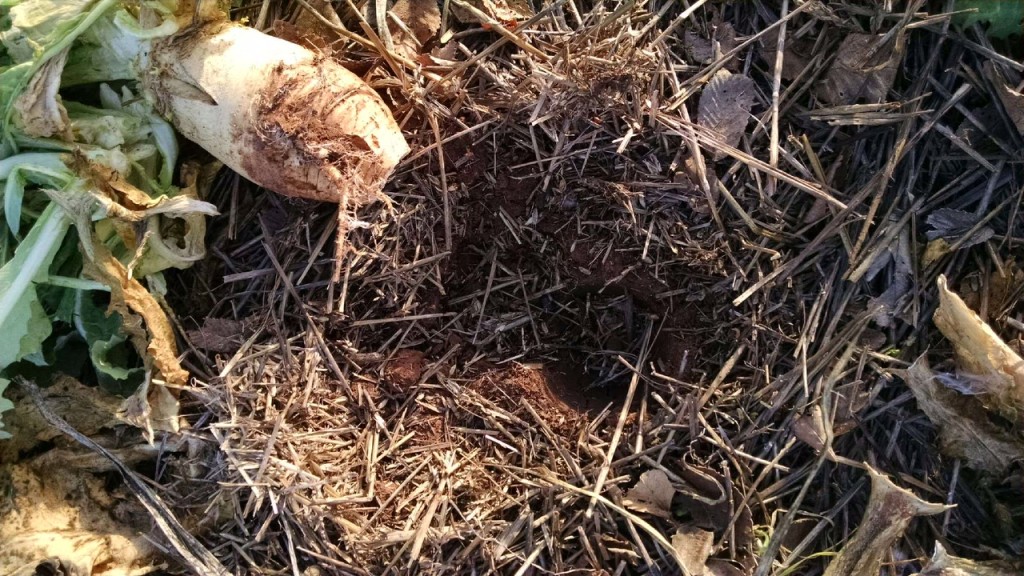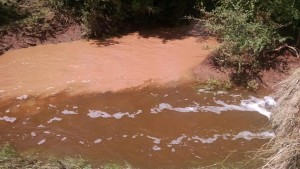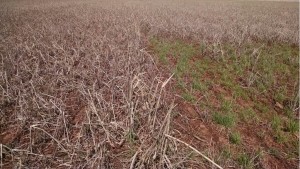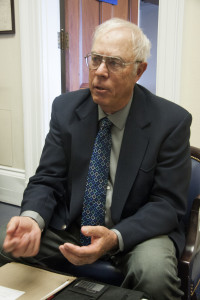This is the final piece in a four-part series chronicling stories from farmers and ranchers who have experienced success with the Conservation Stewardship Program (CSP). The first three stories featured Alabama ranchers Miguel Otero and Cornelius Joe, as well as Stan Armstrong from Indiana.

Conservation Stewardship Stories: Leon Sowers
Leon Sowers always keeps an eye on the weather, and in the last few years he has seen nearly every kind of extreme weather hit his central Kansas farm – from extreme drought, to scorching temperatures, to flooding rains. Twenty years ago, weather this extreme would have been disastrous for his Sowers. Thanks to the Conservation Stewardship Program (CSP) and careful land management, however, Sowers has been able to produce record crop yields despite the harsh and unpredictable weather.
Sowers began farming full-time in 1972 and has been practicing continuous no-till agriculture on his farm in Murdock, Kansas for the past 18 years. Like many other early adopters of no-till and cover cropping farming, Sowers relied on the support and resources of a tight-knit network of fellow farmers to help him make the transition to conservation farming.
After nearly two decades of working to restore and bolster the soil health on his farm, Sowers has benefitted greatly from U.S. Department of Agriculture (USDA) programs like CSP, which help farmers to improve the sustainability and profitability of their farms. Sowers enrolled in CSP in 2012 because he needed help maintaining and expanding conservation practices like no-till and cover cropping on his farm.
“I’ve never had more fun, made more money or raised more crops in my life than I have in the past few years. Maybe my kids, the next generation, can benefit from what we did and what we learned,” says Sowers.
CSP is administered by the USDA’s Natural Resources Conservation Services (NRCS). The program provides comprehensive conservation assistance to whole farms by offering farmers technical assistance and the opportunity to earn payments for actively managing, maintaining, and expanding conservation activities while they continue to produce food, fiber, and energy.
“These [USDA] programs are designed to promote soil, water, and wildlife conservation. I’ve been able to take advantage of CSP to help me improve grazing distribution, rotational grazing, spray drift reduction, and sprayer accuracy. On our farm, we have reduced wind and water erosion, reduced runoff by increasing water infiltration, and increased wildlife habitat by not disturbing the soil,” said Sowers.
Sowers grows wheat, grain, sorghum, soybeans and sesame and runs a 100-head cow and calf operation on his 3,300 acre farm in south central Kansas. When he started farming in the 1970s Sowers utilized conventional tillage practices, which use plows to dig deep into the soil and turn it over. This practice disturbs the root systems and other organic matter that hold topsoil in place, allowing it to be carried away with each strong wind or heavy rainstorm.
“Soil erosion is a major problem on most, if not all farms in the United States,” said Sowers. “The soil on my farm and in our region is a heavy, red clay soil. It is not too affected by wind, but it is very vulnerable to water erosion. [When we were plowing] you could see we were losing tremendous amounts of soil and water.”
No-Till Saves Soil and Increases Yields
Frustrated by the loss of topsoil on his fields, Sowers switched to no-till farming in 1998. Continuous no-till farming mimics the natural environment more closely than any other method, because with the exception to placing in seeds, the soil is left undisturbed. By using no-till methods, crop residue (the plant materials left in a field after the crop has been harvested, like stalks, stems, and leaves) remains in the fields, where it can protect and enhance the soil. In addition to reducing erosion and improving soil quality, no-till farming also helps to

store carbon and slows the evaporation of water.
“We are raising crops and yields that we never could have before. Our soil health is a 180° turn around compared to what it used to be,” says Sowers.
Sowers’ commitment to soil health has not only improved his lands, it has also helped him to save energy and money he would otherwise have spent on fuel and chemical inputs.
“We sold all of our equipment that we had,” said Sowers. “We just put them on the market and sold everything. Now we’re going to the bank with more money than we ever did with tillage. We are getting higher yields with tremendously less cost in it.”
From no-till to whole-farm conservation
In addition to supporting the continuation his no-till efforts, CSP has also helped Sowers to expand his cover cropping practices and to improve his nutrient application process and cattle grazing practices.
Sowers’s CSP contract includes several conservation activities (know as “enhancements”) that support cover cropping. The cover crops he plants help his soil to recycle nitrogen, which reduces Sowers’ reliance on chemical nutrients, and his use of integrated deep-rooted crops aid in breaking up soil compaction.

“Many of the grain crops that we grow have short roots and are unable to dig deep for nutrients,” Sowers said. “We started planting cover crops with deep roots, like radishes, sunflowers, and sun hemp that can dig deep and bring nitrogen and phosphorus back to the surface. They also help with water drainage and protect the soil from erosion,” Sowers explained. “Our goal is to keep crops in the soil 365 days a year.”
When Sowers does have to apply additional nutrients to his crops, Sowers utilizes support from CSP to incorporate targeted spray technology on his farm. This technology allows farmers to more precisely apply agricultural nutrients, and to reduce the drift of chemicals away from the intended target when spraying. These improvements limit damage to desirable plants and animal habitats, reduce water pollution, and reduce particulate matter in the air that contributes to the formation of ozone pollution in the atmosphere.
CSP Supports Pasture Management Too!
Prior to working with CSP, Sowers practiced deferred rotational grazing – a form of pasture management that divides pastures into blocks, allowing one pasture to rest for an entire season while the other is grazed. Deferred rotation grazing can be challenging because it causes cattle to selectively eat their favorite grasses; meanwhile the rested pastures often mature too quickly.
To address this problem, CSP helped Sowers alter his rotational grazing schedule so that the cattle would move more often between pastures, which prevented grass from getting too mature and encouraged more even grazing . Sowers also began rotating his water and mineral sites to improve grazing and nutrient distribution while reducing ground compaction and grass killing. These changes have made a huge difference in the health of Sowers’ pastures.
“I think we are doing a really great on our pasture management with CSP,” said Sowers. “When we come out of pastures after a rain, we see a lot of top growth, which is essential to establish strong roots. It is amazing to see it grow.”
Seamless Contract Renewals Allow for Continued Conservation
Because Sowers originally enrolled in CSP in 2012, his farm is part of the 12 million acres that are now up for renewal. Sowers has had such success with CSP that he recently applied to renew his contract for an additional five years. All in all, there are nearly 900,000 acres in Kansas that were originally enrolled in CSP in 2012. These acres will expire out of the program at the end of the year if they are not renewed by March 31.
From Farmer to Ag-vocate
After reaping the rewards of no-till agriculture, Sowers decided to put the time he had previously spent tilling toward educating others about the benefits of sustainable agriculture.
“When we talk about sustainable agriculture, it has a negative stigma for some farmers,” said Sowers. “I think about sustainable agriculture as leaving the next generation with farmland that is as good, if not better than what we have now.” “We can afford to lose a lot of things,” Sowers said, “but the United States cannot continue to lose an average of 3 tons of topsoil per acre from our farmland each year. It is the most essential piece of agriculture.”
Sowers is a proud member of the South Central Kansas Residue Alliance (SCKRA), a group of farmers and conservationists who strive to improve the knowledge base of local producers in the practices of no-till, cover crops, crop rotation, incorporating livestock and building soil health by keeping the soil covered and promoting increased soil biology. In 2014, SCKRA utilized funding from the Sustainable Agriculture Research and Education (SARE) program to produce a documentary titled, “A Framework for Change- One producer, one farm at a time”. The documentary educates other farmers about the practices and change in mindset that it takes to transition to conservation farming methods. Sowers also serves on the boards of the National Sorghum Producers and the Kansas Association of Wheat Growers.

Sowers advocacy isn’t just local, however. In March 2016 Sowers traveled to Washington as part of the National Sustainable Agriculture (NSAC) farmer fly-in. While in the capital Sowers met with Senator Jerry Moran (R-KS) and Representative Kevin Yoder (KS-3) to discuss the benefits of sustainable agriculture programs like CSP, SARE, and the Environmental Quality Incentives Program (EQIP). Supported by NSAC, Sowers advocated for increased and maintained funding for these critical programs, which help farmers like him to do more on their land with less.
“I appreciate all the work Senator Moran has done to support these critical conservation programs over the years,” said Sowers. “I know Representative Yoder has been very supportive as well… and that’s going to go a long way for farmers in Kansas, and across the country.”
Conservation Stewardship Program Sign-up Happening Now
This year, funding has been made available to enroll an additional 10 million acres in CSP. Farmers and ranchers have until March 31 to submit the initial application. Current CSP participants who enrolled in 2012 also have until March 31 to renew their contracts for an additional five years before they expire at the end of this year.
In order to support farmers and ranchers and encourage their involvement in this important program, the National Sustainable Agriculture Coalition (NSAC) has released its CSP Information Alert, a step-by-step sign-up guide to the program with full enrollment details, including a complete list of all conservation activities that qualify for awards.
NSAC has also published the more detailed Farmers’ Guide to the Conservation Stewardship Program, which includes enrollment guidance, key definitions, and explanations of the ranking and payment system, and helpful hints for accessing the program.
Printed copies of the Farmers’ Guide can also be purchased. To inquire about ordering printed copies, email NSAC at intern@sustainableagriculture.net.

